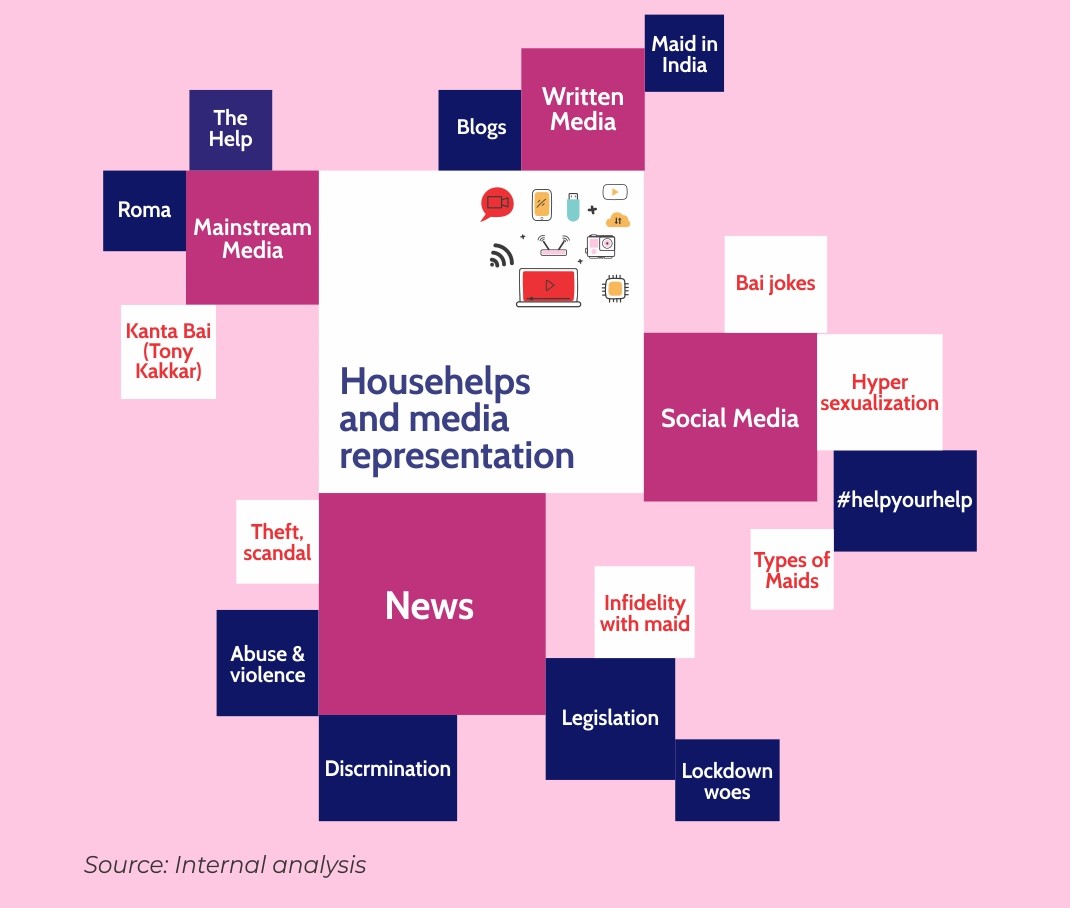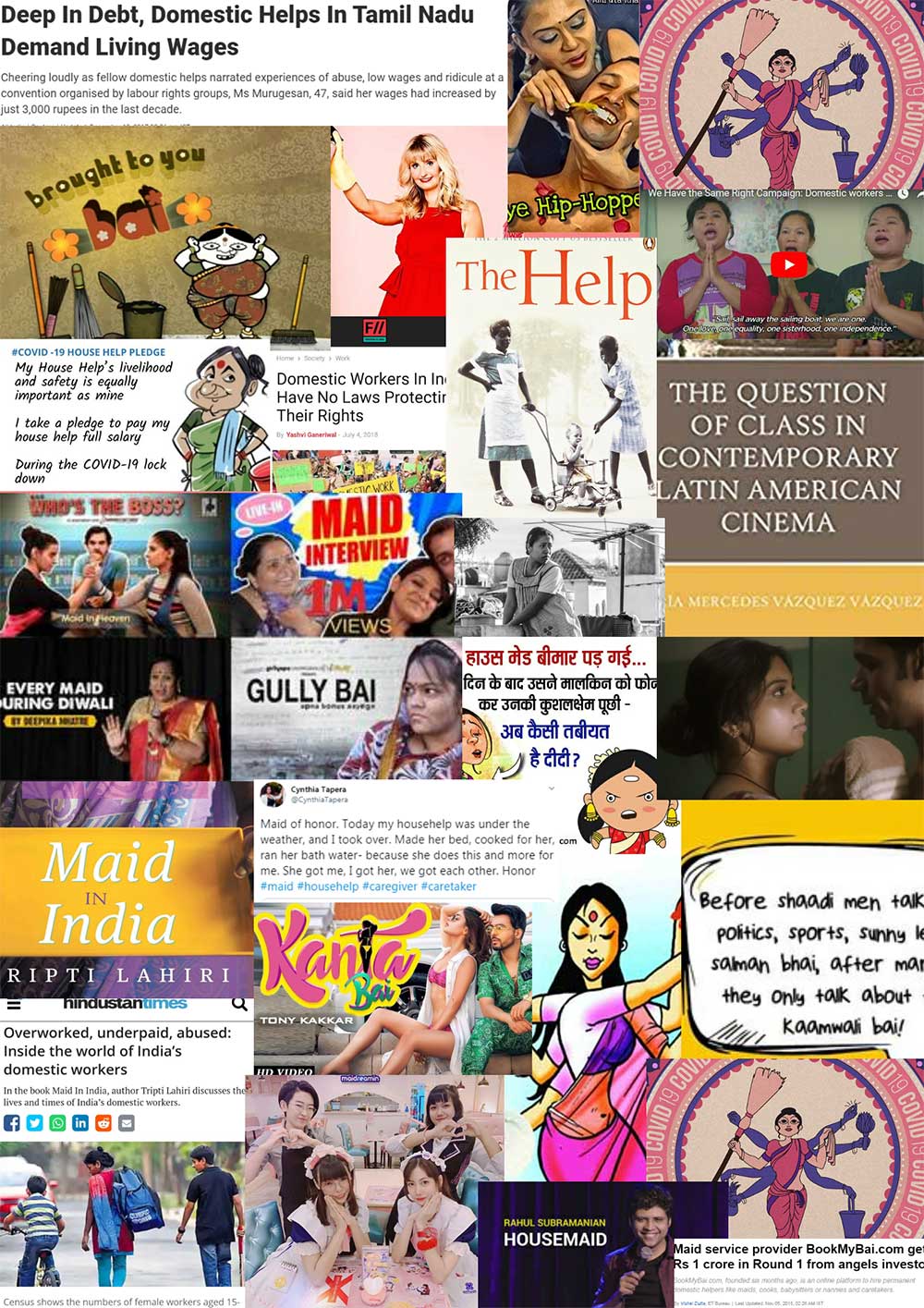July, 2020
An objective analysis of the representation of domestic workers in the private sector
7 minutes read
There is a stark contrast between how domestic workers are perceived in the popular media vis-a vis the actual reality of their lives. On one hand, a bunch of people are probably laughing at WhatsApp jokes about extramarital affairs between the husband and the maid while on the other hand, some organizations are demanding better pay for them. This polarity highlights the need for greater social outreach. One may ask, why does it matter? Is it pragmatic to invest time and effort into bringing about behavioral change in the society? The answer is yes. People’s perception of domestic workers can go a long way in determining the market conditions that can be beneficial or harmful for them. Let’s see how.
The private sector consists of many important actor groups viz. employers/customers, influencers, agencies, advertisers, product/service companies, etc. that are relevant to workers in the unorganized sector. It can tell us a lot about the expectations, preconceived notions and apprehensions pertaining to domestic workers and how it affects them on a personal and professional level. This article is an attempt to discern the current general outlook on domestic workers in the private sector through a qualitative analysis of insights from various sources such as news headlines, social media posts, hashtags, pop culture references and on-screen representation.

News Media
Let’s start with news channels. The news media tends to give us a clearer picture. They influence the perspective of a considerable section of the society on a regular basis. The kind of content they choose to publish can affect how people think about their housemaids and domestic work in general. The common themes with respect to domestic work include:
- Legislation – laws, legal rights (Centre and State policies), workers’ rights, wages and social conditions pertaining to them
- Abuse and Violence – various instances of violence and abuse faced by domestic workers at home and workplace
- Discrimination – caste, class, gender and nationality-based discrimination, especially when intermixed with abuse
- Theft, extramarital relations and scandals
- Online maid services – various maid services, agencies, training organizations and tech companies that work for/with domestic workers
- Lockdown woes (faced by domestic workers during the 2020 Covid-19 outbreak)
Overall, it can be said that the representation of domestic workers in the news is largely objective and a lot of times, even considerate and sensitive towards their struggles.
While news stories about thefts and affairs can make employers overly cautious, making them aware of the hardships that their domestic helps go through can lead to more compassion and empathy from the employer’s end in terms of wages, paid leaves, health issues and financial support.
Social Media
Social media, however, is a whole different territory.
From WhatsApp jokes about the bai “ruling” the household to YouTube comedy sketches about ‘Types of Maids’, popular media paints a distinct picture of domestic workers.
Given that outreach and social engagement on these platforms is increasing more than that on authentic news headlines, they are likely to shape people’s opinions to a larger extent.
Facebook and WhatsApp are two of the most commonly used apps by people of all ages. It has the maximum potential to influence the private sector, most importantly, the employers. Jokes based on housemaid stereotypes are regularly circulated on these apps. Warnings about “cunning” or “dominating” maids and “real” videos of them stealing a costly item from the house or cheating in some way are frequently shared.
The everyday jokes about “precocious” maids “seducing” the husbands could create distrust and generate subtle power-rivalry between the worker and the female employer.
False news stories and hoaxes about domestic workers stealing from her employers can make many households paranoid and overly cautious.
Hypersexualization of domestic workers could contribute to sexual harassment and victim-blaming. Moreover, it might be leading to paranoia and unfavourable power dynamics in the workplace. “Harmless” jokes which portray maids as “bossy” and “sly” could in fact worsen the vulnerability of their situation. Certain employers even fear being dominated or manipulated by their house helps, and hence adopt a stricter demeanour towards them
Nevertheless, it is not all bad news. NGOs, civil organizations working for the welfare of domestic workers also utilize these platforms to spread awareness and influence the masses. Domestic workers across the globe are part of certain Facebook groups wherein they share information, tips, stories, and job opportunities. During the Covid-2020 pandemic, many celebrities, influencers, and citizens on sites like Twitter vowed and/or urged others to pay their domestic help and support them.
Mainstream Entertainment Media
Mainstream entertainment has the ability to sway audiences on a large scale. It includes mediums like cinema, television, music industry, books, blogs, and other forms of online entertainment content. We, as viewers, are constantly internalizing messages and signals at conscious and subconscious levels. Through SIE (see para 1), there is great potential to create more opportunities for increasing awareness, increasing social activism, and changing public perception on these issues.
Movies like Roma (2018), The Help (2011), Delhi in a Day (2011), Sir (2018) feature primary characters as domestic workers. While some are praised for their accurate portrayal (Roma, for instance), some are heavily criticized for indirectly reinforcing stereotypes (for example, The Help). Modern Hindi films like Thappad (2020), Piku (2015), Lust Stories (2018) also depict the lives of domestic workers.
The Indian television has played a major role in strengthening conventions about housework being a woman’s obligation. A study published in the Journal of International Women’s Studies based on 30 TV serials that aired from 1990-2016 and 14 old and new TV advertisements, shows that most women are depicted doing household work. Notions like these undermine the nature of work performed by domestic workers to such an extent that it ceases to be even considered as “work”.
The Japanese manga/anime culture fetishizes maids by portraying them as young, attractive, subservient and extremely innocent. Hyper-sexualization of domestic workers is more common than you would think.
Tony Kakkar’s song Kanta Bai is a gross example.
Housemaids are a not-unusual theme even for comedians. Comedian Kenny Sebastian talked about his housemaid in one of his anecdotal specials, which you might have come across. It highlighted the distrust between employers (here, his mother) and domestic workers. At one point, his mother asks him to keep an eye on the maid. “What if she steals the TV?” she says, “I have heard stories, okay?” He also talked about the awkward dynamic between young male members of the family and the house help. While these jokes depicted the everyday scenario, comedian Sumit Anand, who works from home, complained that his “maid does not respect” him and thinks that he is a loser. He goes saying, “Which is not wrong, but she should not think that.” This incited laughs aplenty. In another video, comedian Rahul Subramanian talks about his “dust-allergic” housemaid who “does not do her work properly”. Although funny on the outside, the insensitive and hierarchical ideology behind these jokes is hard to ignore.
On the other hand, Deepika Mhatre, a domestic worker from Mumbai also performs as a stand-up comedian. She appeared in an interview by another fellow comedian, Aditi Patel titled Bad Girls. In her pieces, she talks about her work and housemaids in general, which is refreshing but at the same time insightful to watch.
There are quite a few books, blogs, and articles based on domestic workers. Tripti Lahiri’s book, Maid in India: Stories of Inequality and Opportunity Inside Our Homes, and Maria Mercedes Vázquez’s recently The Question of Class in Contemporary Latin American Cinema talk about the treatment of maids in the Indian society and Latin American cinema respectively.

So how can these platforms share, generate, and sensitize people towards the plights of domestic workers? Many studies have proven that by harnessing the aforementioned platforms we can bring about large-scale change in people’s understanding of women in the informal industry, especially their domestic help. This can be done using tools like Social and Behavioral Change Communication (SBCC or BCC), strategic use of communication channels to promote positive outcomes, and Social Impact Entertainment (SIE), use of mainstream entertainment forms, predominantly films and TV, which intend to have social impact next to great entertainment value. By employing a systematic process beginning with formative research and behavior analysis, followed by communication planning, implementation, and monitoring and evaluation, it is possible to achieve defined behavioral objectives in the unorganized sector.
Let me simplify that for you – if the media channels showed us the real, harsh reality of domestic workers instead of the fetishized version of it, there is a high chance of bringing about effective changes in the present scenario. Meanwhile, what we can do is to try and identify problematic content and discourage it. A small effort from our side could lead to a large-scale transformation.
References
- What is social and behavior change communication?: Social and Behavior Change Communication for Emergency Preparedness Implementation Kit
- Gendered Portrayals of Domestic Work in Indian Television: Journal of International Women’s Studies by Ruby Jain and Surbhi Pareek
- #maid: Instagram
- ‘Domestic Workers’ Public Group: Facebook
- #COVID19HousehelpPledge: Twitter
- Kanta Bai song by Tony Kakkar
- My Job, My Home & The Maid by Sumit Anand
- Housemaid by Rahul Subramanian
- Me, My Mother & Our Maid by Kenny Sebastian
- Aam Aadmi Ki Khaas Kahani by Deepika Mhatre – A Maid who is now a Stand Up Comedian

[…] a certain class bias that we operate with- at our homes, workplaces and in the media. In mainstream media, a maid is often depicted from the lens or gaze of the rich family (think Daijaan from Kabhi Khushi […]